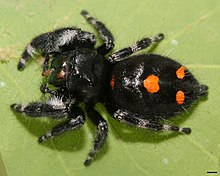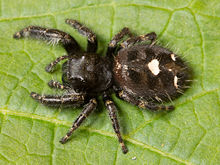
Back فيديبوس اوداكس ARZ Phidippus audax Catalan Phidippus audax CEB Phidippus audax German Phidippus audax Spanish عنکبوت جهنده بیباک FA Phidippus audax French Phidippus audax ID Phidippus audax Italian Phidippus audax MIN
| Phidippus audax | |
|---|---|

| |
| Female in Columbia County, Florida | |
| Scientific classification | |
| Domain: | Eukaryota |
| Kingdom: | Animalia |
| Phylum: | Arthropoda |
| Subphylum: | Chelicerata |
| Class: | Arachnida |
| Order: | Araneae |
| Infraorder: | Araneomorphae |
| Family: | Salticidae |
| Subfamily: | Salticinae |
| Genus: | Phidippus |
| Species: | P. audax
|
| Binomial name | |
| Phidippus audax (Hentz, 1845)
| |

| |
| Synonyms | |


Phidippus audax, the Bold jumper or Daring jumping spider, is a common species of spider belonging to the genus Phidippus, a group of jumping spiders easily identified by their large eyes and their iridescent chelicerae.[1][2] Like all jumping spiders, they have excellent stereoscopic vision that aids them in stalking prey and facilitates visual communication with potential mates during courting.[1] Bold jumping spiders are native to North America and have been introduced to Hawaii, Nicobar Islands, Azores, and the Netherlands.[3][4][5] They are typically black with a distinct white triangle on their abdomen.[3]
Bold jumping spiders are solitary carnivores that use their highly specialized eyesight to actively hunt and stalk prey.[3] They prey on a variety of insects and non-insect terrestrial arthropods such as caterpillars, dragonflies, grasshoppers, and other spiders.[3][6][2] They are one of the most common spiders found in agricultural areas and have been studied to determine their impact on crop pest populations.[6] Unlike most spiders, bold jumpers do not build webs to catch prey.[6]
These spiders can be found in temperate climates in a variety of terrestrial habitats including grasslands, chaparrals, open woodlands, and agricultural fields.[3][4][2] The bold jumper is one of the most commonly occurring spider species within its range and is often found living in close proximity to humans.[2][7] Bites from Phidippus audax are rare but may occur if they feel threatened or are mishandled.[2][7]
- ^ a b Jackson, R., & Richman, D. (1992). A review of the ethology of jumping spiders Araneae Salticidae. Bulletin of the British Arachnological Society 9.http://peckhamia.com/hosted/Richman%20Jackson%201992%20A%20review%20of%20the%20ethology%20of%20jumping%20spiders.pdf
- ^ a b c d e Edwards, G. B. (1980). Taxonomy, ethology, and ecology of Phidippus (Araneae: Salticidae) in eastern North America. University of Florida.
- ^ a b c d e Hammond, George; Knight, Katie. "Phidippus audax". Animal Diversity Web. Retrieved December 4, 2022.
- ^ a b Edwards, G.. (2004). "Revision of the Jumping Spiders of the Genus Phidippus (Araneae: Salticidae)" Occasional Papers of the Florida State Collection of Arthropods Volume 11. Collect. Arthropods. 11.https://www.fdacs.gov/ezs3download/download/25106/516022/Media/Files/Plant-Industry-Files/Edwards_2004_Revision_Phidippus.pdf
- ^ "NMBE - World Spider Catalog". wsc.nmbe.ch. Retrieved December 4, 2022.
- ^ a b c Bailey, Charles L (January 28, 1969). LIFE HISTORY OF THE SPIDER, LIFE HISTORY OF PHIDIPPUS AUDAX (HENTZ), IN RELATION TO BIOLOGICAL CONTROL OF GRAIN SORGHUM INSECTS (PDF) (Thesis). Oklahoma State University.
- ^ a b "Phidippus audax". escholarship.org. Retrieved December 4, 2022.